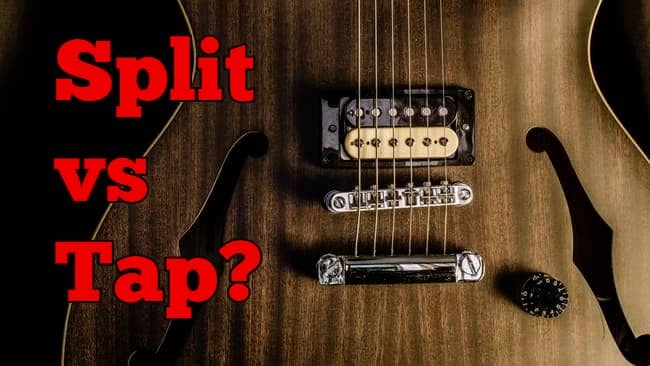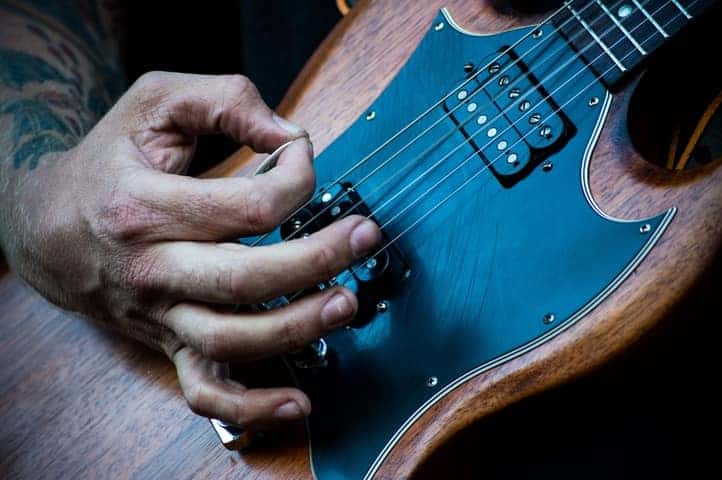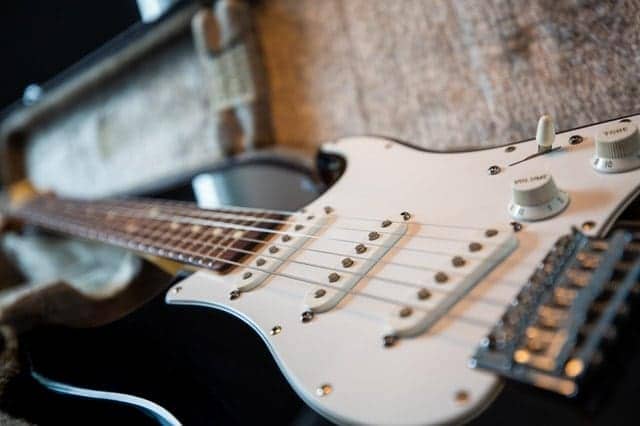
When it comes to
In this post, I will explain the differences when it comes to function and tone between both pickup modifications and in the process unravel the confusion between both.
So what are the differences between ‘coil splitting’ and ‘coil tapping?’
Coil splitting is essentially de-activating one side of the humbucker using a ‘push-pull pot’ leaving one single coil left within the signal which ‘splits’ the humbucker. ‘Coil tapping’ is deactivating a certain amount of copper wraps around the coil lowering the ‘output’ of the pickup.
Now you have the short facts between both
Let’s go deeper so you can fully understand the function and differences in sound.
How Coil Splitting Works
Before we get into the mechanics of coil splitting, first it would be useful to familiarize ourselves with the anatomy of a humbucker.
As we all know, a humbucker is essentially two single coil pickups paired together wired in opposite polarity.

This pairing produces a ‘thicker’ and ‘warmer’ tone compared to the ‘thin’ and ‘bright’ tone of a regular single coil pickup.
It also has the major benefit of removing the interference and humming issues commonly known as ‘60-cycle hum’ from the signal.
Noise and humming issues are infamous with guitars adopting single coil pickups, although they excel when it comes to ‘clarity’ and ‘definition’, the drawback is that they cannot cancel their own noise.
Hence why humbuckers have been are the staple for heavy rock and metal players. They are better equipped to combine with high gain distortion/ without any unwanted noise, buzzing and for a bigger and beefier tone.
Function
Anatomy lesson over, so why should players consider adding coil splitting to your guitar?
As mentioned, coil splitting is essentially deactivating one side of the humbucker pickups leaving you with the one remaining coil in use within the signal.
This pickup modification, therefore, allows humbuckers to convert and function as
Benefits of Coil Splitting?
So what is the benefit of this wiring modification? Essentially coil splitting offers the best of both worlds allowing players to seamlessly switch between a humbucker or single coil pickup via the push pull pot knob.
Essentially, it changes the guitars dynamic from a ‘warmer’ and ‘beefier’ tone of a humbucker, to a ‘crisp’ and ‘thinner’ tone of a single coil at the flip of a switch or pull of the tone knob.
adding more ‘chime’ and ‘twang’ for a more ‘piercing’ sound. Splitting increases the ‘top-end’ frequencies and removes the ‘low-end’ frequencies adding versatility to your guitar setup and increasing your guitar’s range of tones.
Coil splitting is a handy feature for quickly switching to a thinner sound either having to change guitars mid-set adding versatility but also convenience.
With a pull of the tone knob, bottom-end frequencies will be removed by disabling one of the two single coils in the electronics.
Have a listen …
Coil splitting is useful for the usual humbucker guitars that are ‘thick’ and ‘beefy’ sounding such as a Les Paul. Allowing you to suddenly loose a bit of bass and add ‘clarity’ from the usual ‘warm’ humbucker sound.
Using the coil splitting feature on a Les Paul can be useful for an overdriven lead tone for more bite and articulation for a sound similar to a PRS tone.
Coil splitting can add versatility for a number of tones. However, in my opinion coil splitting is best used for optimising clean tones.
As we all know, single coils are the ‘king’ when it comes to producing ‘clear’, ‘bright’ and ‘articulate’ tones when combined with a thin body guitar. The combination that gives the Stratocaster and Telecaster its iconic sound.
The Drawbacks
Keep in mind, although coil splitting adds versatility to your guitar.
Don’t suddenly expect your ‘thick’ and ‘woody’ sounding Les Paul to magically turn into the tone of a ‘thin’, ‘bright’ and ‘twangy’ Strat or Telecaster for example.
Although it does sound similar to a single coil and can add definition to the usual ‘warm’ and ‘dark’ tone of a humbucker.
The reason you do not get the full experience is that a thin guitar tone comes from more than just the pickups. The amount of wood on the guitar is also a big factor impacting the tone and dynamics.
Not the Full ‘Single Coil Experience!’
Although coil splitting removes one of the two single coils from the signal, unfortunately you can not remove the amount of wood that resonates within your guitars body.
Meaning a thick sounding Les Paul will always have some of its remaining warm character because of its chunky body even with coil splitting activated.
However, do not underestimate coil splitting uses. It is a useful feature to have installed with a humbucker guitar and can certainly add some change and character to your tone.
Most modern solid body guitars include coil splitting for a nice optional change of sound and dynamics at your disposal.
Is Coil Splitting Worth it?
It must be noted, coil splitting is a useful feature for adding versatility and flexibility to the endless tonal options for any guitar player.
However, it is viewed as more of an added feature than an ‘essential’ I must admit.
For a guitarist who wants the full blooded single coil experience achieving a specific sound. Then using a guitar with a single coil is obviously going to be the best option than a humbucker that is trying to imitate its opposite number.
For using live however, coil splitting does have its uses for switching tonal dynamics without a guitar change.
It also opens a new possibility when it comes to the endless choice of tones and sounds. Especially when it comes to the drastic dynamics between single coils and humbucker pickups.
Whether you view them as an ‘essential addition’, is up to you to decide!
How Coil Tapping Works
Coil tapping is different animal altogether, but sometimes can get confused with coil splitting.
As we all know, a single pickup is comprised of a magnet and thousands of wraps of copper wire.

Depending on the pickup and manufacturer, each pickup can be wrapped in a varying amount of copper wire (usually in the thousands mark.)
Depending on what the manufacturer decides how much will sound optimal for that particular pickup.
The more wraps of copper wire around the coil, the more output is produced resulting in a ‘hotter’ pickup.
For this example, say this pickup includes a maximum of 5000 wraps of
This is wired to a push pull pot connected to your guitar knob and when activated, ‘taps’ into that copper wire location on the winding.
This drops the output of the pickup to a lower amount due to fewer copper wraps being activated (at the 2000 wraps in this case.)
Coil tapping therefore gives the guitar player two distinct output levels from the guitar for variations in gain and tone.
In a nutshell coil tapping inactivated produces a higher output pickup and when activated, produces a lower output pickup.
What Does ‘Output’ Mean?
A higher output pickup sends a ‘hotter’ signal to your amplifier than a low output pickup, meaning it is more likely to distort and saturate.
Tube amplifiers are known to b
Hence why guitars built for the metal genre mainly include active pickups (and some high output passive pickup models.) These pickups will include more copper wrap around the magnet than traditional pickups.
Why? Because more windings results in more ‘output’ producing more gain and distortion potential for ultra high gain and saturated tones for the staple sound of metal.
If I was to order the lowest to highest output pickups it would go something like this….
- Passive Single coils – Low output
- P90s – low to mid output
- Passive humbuckers – mid output
- Active pickups – high output
- Ceramic pickups – high output
How Can Coil Tapping Be Useful?
Having a guitar that has quick access to alternative output levels adds versatility. For example…
Coil tapping can be a useful modification for quickly dropping the output for tonal variation.
An example is activating coil tapping for a more ‘crunchier’, mid-gain and vintage tone. Whereas, the default untapped setting can be used for a modern high-gain voiced sound.
Another useful example is if playing live and you need to quickly need to drop the dirt on your guitar for a section of a song.
Instead of backing off the gain by rolling down your guitars volume knob. Alternatively, you could quickly engage the coil tapping to quickly drop the gain instead of fiddling with your controls.
Meaning you can concentrate on what is more important….your playing.
More Overdrive
Another way is utilizing the coil tapped setting for rhythm heavy parts of a song. The full output option can be used for full-blown solos and high gain goodness.
Also experimenting with these settings with different amps and effects is another way to utilize the most out of coil tapping.
There are many ways a guitar can be wired and modified for activating a coil tapping feature. The main way is via a push pull pot.
Other alternatives are an independent selector switch for each pickup. Even adopting a ‘5-way selector’ switch similar to the one standard on stock Stratocasters.
Related Questions
Is coil splitting available for single coil pickups?
Coil splitting is only available for humbuckers not single coils pickups, as this wiring modification requires a humbucker (two single coils) in order to deactivate one for the remaining single coil to be used within the guitar signal.
Can any humbucker be split?
Only humbuckers with the correct exposed conductor wiring (red, green, white, black) with a remaining earth wire can be split, typical of modern manufactured humbuckers. Older vintage humbuckers including the single braided pickup wire
